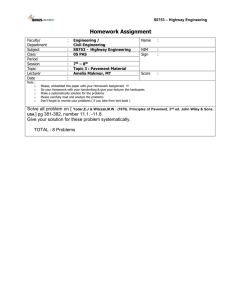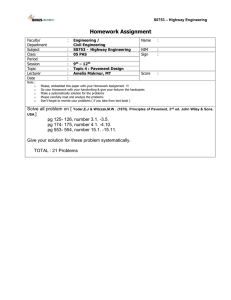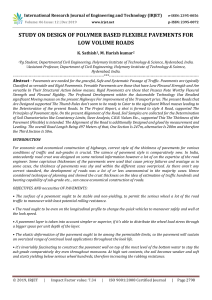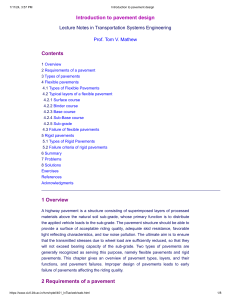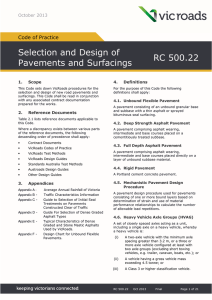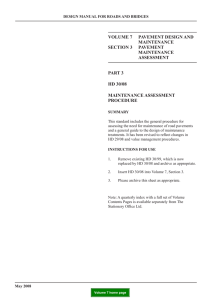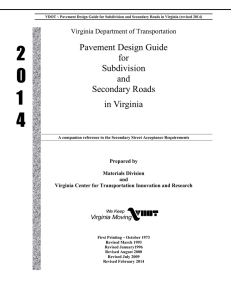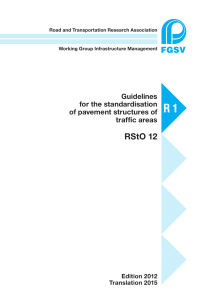Pertemuan 05 <<Judul>> Matakuliah : S0182/Studi Kasus Dalam Teknik Sipil
advertisement
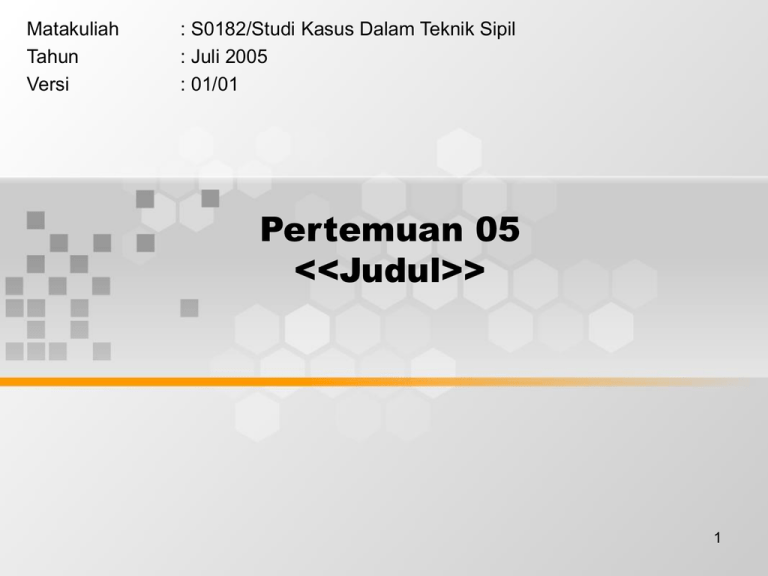
Matakuliah Tahun Versi : S0182/Studi Kasus Dalam Teknik Sipil : Juli 2005 : 01/01 Pertemuan 05 <<Judul>> 1 Learning Outcomes Mahasiswa dapat memperhitungkan berbagai kemungkinan dan memilih alternatif yang terbaik bagi penyelesaian masalah. C3, C4 2 Outline Materi • Kasus yang selalu dijumpai di proyek • Kasus yang mungkin terjadi dengan kondisi khusus • Analisa pemecahan masalah 3 • "Fatted-up" Surface Dressings The most common sites where retexturing with "High Pressure Water" is undertaken are fatted up surface dressings as shown to the left. You will see on this site large areas of the road surface have completely fatted up leaving a smooth surface with no texture at all. 4 Pavement Design • The road pavement is the actual surface on which the vehicles will travel. It's purpose is two fold, to provide friction for the vehicles and to transfer normal stresses to the underlying soils. The procedure described in this page is that in the Design Manual for Roads and Bridges, Volume 7 (Available on-line at http://www.archive.officialdocuments.co.uk/document/ha/dmrb/index.htm.) • The design Process can be split up into different areas. These are as follows: • Foundation Design - That is the design of the Subgrade and subbase • Thickness Design - That is the design of the actual road surface • Unfortunately to include both of the areas on this page would cripple your browser so they have been split up and this page contains only the introduction and links to the different areas. 5 PAVEMENT • • • • • • • • There are four types of pavement currently in use in the United kingdom at present: Flexible - pavements with a bitumen bonded surfacing and roadbase. Flexible Composite - The surfacing and upper road base are bituminous on a lower roadbase of cement bound material Rigid - Pavements with a concrete surface slab which can be un-reinforced, joint reinforced or continuously reinforced. Rigid Composite - continuously reinforced concrete slab with a bituminous overlay. Although there has been considerable advance in the theoretical design of pavements, most of the current work is based on empirical methods and design charts. For this reason only these methods will be covered in these pages. Normally a design is carried out for each of the alternatives and then the most economical chosen. However, if for environmental or technical reasons one is impractical then it may be omitted. The general form of the different types of pavement is shown below. It can be seen that common to all types of construction is the Sub-base and subgrade. It is this aspect of the design which is treated first. However, it is first necessary to decide on a failure criteria on which to base the design. 6 FAILURE CRITERIA • • • • • This has been the subject of extensive research and is the result not of theory but of full scale tests and observations of real life situations. Croney1 states that permanent deformation in the near side wheel tracks of a flexible pavement of 20mm, when measured from a 1.8m straight rule, was normally accepted as the point at which reconstruction was considered necessary. It was also noted that at this point the surface was beginning to crack. This led to water ingress and subsequently rapid deterioration. The critical condition was much harder to define although it was found generally that overlays were being provided between deformations of 10 and 20mm. Cracking at these points was generally limited to longitudinal cracks in the wheel tracks. The advantage of this method is that it is easily measured by visual inspection and a straight edge. Methods used in the United States including asking passing motorists to rate the trafficability between 0 and 5 and a slope variance device. Salter2 contains more information on both these methods as well as other relevant ones. 7 8 Pavement Design - Thickness Design The thickness design of the pavement is the determination of the overall thickness of the road and the thickness of the individual layers. This is of course dependant on the type of material chosen for the road. This is explained in more detail below. The procedure described in this page is that in the Design Manual for Roads and Bridges, Volume 7. 9 10 • Before and after high pressure water treatment The photographs below are before and after sections of the fatted up surface dressing, you will see the pressure of the water has successfully removed the excess bitumen and left an excellent texture. This process is so effective that the biggest danger is "blasting" out sections of the road surface, so great care is needed by the machine operators to ensure the integrity of the road surface is not weakened by the process. 11 12 • High pressure water retexturing / declogging machine Below are pictures of a typical machine for doing this type of retexturing, it has to be able to carry large amoiunts of clean water so its basic shape is that of a "tanker". It has a row of spinning heads at the rear of the machine which actually spray the water, there is usually just one jet on each spinning unit and complete coverage of the road is due to the spinning action. If the head stops spinning while the jet is still spraying you will quickly have a small hole in the road surface. 13 14 • Relative Hydraulic Conductivity This particular machine carried its own apparatus for testing the relative hydraulic conductivity ( porosity ) of "Porous Asphalt" when the machine was being used for "de-clogging" the open texture of that surfacing material. This test is a measure of how quickly the water will drain through the porous asphalt matrix.. Initially the test will be performed shortly after laying to check that the material/surface complies with the specification. The method of the test is to be found in BS DD 229 : 1996. It will also be performed from time to time to test that the interconnecting voids which allow drainage have not become clogged, and to test the effectiveness of any "declogging" operations. 15 16 • Description of the Process The rotating assembly of bars carrying the individual discs is positioned very accurately above the road surface so that only slight contact is made with the aggregate at the road surface. In this position the aggregate is successfully roughened without causing damage to the road surface. The accuracy of this positioning with this process cannot be over emphasised, because if it is set to low not only will the surface course layer receive damage, you may well create a road surface that has longitudinal groves that could be cause for concern for motorcycle traffic. However, performed correctly by an experienced gang this is an excellent process. 17 18 • The Rotating Assembly This picture illustrates the way the individual discs are mounted on the rotating bars. The discs are not fixed but loosely mounted with the bar passing through the central hole of the disc with a considerable clearance, this is so that the once the disc has impacted with the road aggregate it will bounce up as there is no downward pressure from the machine other than centrifugal force. This is providing the rotating assembly is correctly positioned. 19 20


